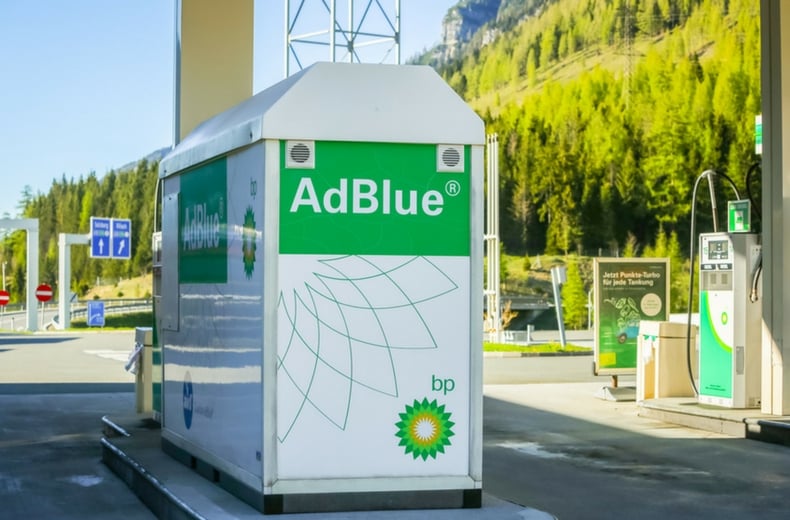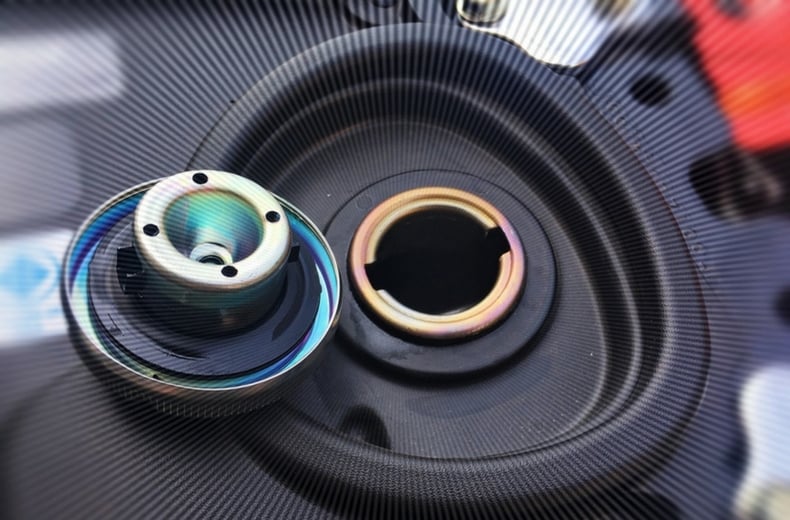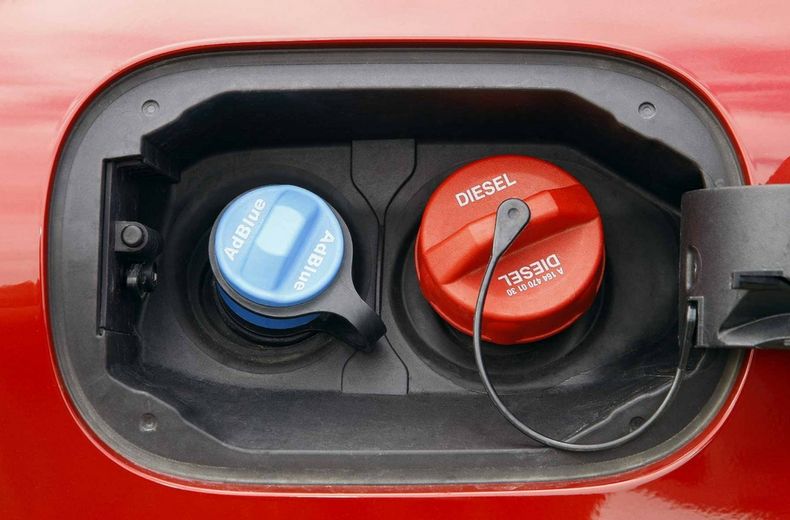But what is AdBlue, how does it reduce nitrogen-oxide emissions and what happens if you neglect to use it? Read on to find out more.
What is AdBlue and why do we need it?

AdBlue is a non-toxic, non-flammable, odourless and biodegradable solution designed to help diesel vehicles meet the latest Euro 6 exhaust emission regulations.
It works in conjunction with a treatment system known as Selective Catalytic Reduction (SCR) and is used by an increasing number of carmakers.
What is AdBlue made from?
AdBlue is made from a urea and water solution, which is stored in a separate tank.
How does AdBlue work?
It is injected into a modified section of the vehicle’s exhaust, where it creates a chemical reaction, removing the harmful nitrogen-oxide emissions (NOx) and converting them into harmless water and nitrogen.
What happens if I don’t use AdBlue?
If a SCR-equipped vehicle runs out of AdBlue, it will fail to start.
But don’t worry, because a warning message will appear on the dashboard, alerting you that the level of AdBlue is running low.
In the case of Volkswagen, the first message appears when the remaining range is 1,500 miles, and is repeated every 62 miles until the range reaches 1,000 miles.
At this point the message turns amber and is repeated every 31 miles.
Eventually, the warning turns red, before the car will not restart and the ignition is turned off.

RAC Breakdown Cover
Limited Time Offer
*£7 a month for new, single vehicle Basic cover. ^For 1 nominated vehicle when added to Extra or Complete cover. New customers only. Ends 29/04/24. 7am.

Does every diesel need AdBlue?
AdBlue should only be used in diesel cars fitted with an SCR system, so if in doubt, consult the vehicle handbook.
As a rule of thumb, the more recently the diesel car was built, the more likely it is to use AdBlue, as the Euro 6 regulations were introduced in 2014. Find out your car's Euro emissions rating here.
For example, SCR technology is fitted to all Land Rover diesel vehicles built from the 2016 model-year, while Jaguar, Audi, Citroen, Peugeot, Mercedes-Benz, SEAT, Skoda and Volkswagen all use AdBlue tech.
How do I refill my AdBlue?
Firstly, consult the handbook to locate the tank filler location along with any special instructions.
Typically, the AdBlue filler will be found next to the fuel filler nozzle, but other locations include the spare wheel well or either side of the boot.
Open the filler cap, usually by hand, although some vehicles require the use of a wheel brace in order to release the cap.
Screw on the connector of the refill bottle and allow the AdBlue to drain into the tank. Some systems require a minimum amount, so consult the handbook.
Peugeot recommends that, due to the position of the tank, the refill is carried out by a local dealer, but says that if you intend to do it yourself, the vehicle must be on a flat surface with the engine switched off.
Be aware that although AdBlue is non-toxic, it is corrosive and can cause irritation to the skin, eyes and lungs.
Wear gloves and wash your hands and arms after filling.
If AdBlue comes into contact with the vehicle’s paintwork, rinse the area with water.
How much AdBlue will my car use?
How much AdBlue you use is determined by a number of factors, including journey type, driving style, environmental conditions and mileage. Some drivers might be fortunate enough not to require fill-ups between annual car services and MOTs.

A passenger car might consume 1.5 litres of AdBlue every 620 miles, with the size of tank determined by the size of car.
For example, the Volkswagen Touran features an 11-litre tank, while the larger Touareg boasts a 19.5-litre tank.
Volkswagen says you can expect the first AdBlue warning message to appear at 3,000 to 4,000 miles in a Touran or 6,000 to 7,000 miles in a Touareg.
Peugeot is more optimistic, claiming the AdBlue will need to be topped up every 12,500 miles.
How much does AdBlue cost and where can I buy it?
A 10-litre bottle of AdBlue should cost around £10 from a motoring discount store, while a main dealer might charge £1.50 per litre. Peugeot offers 10 litres of AdBlue for a fixed price of £9.99.
It’s worth noting that AdBlue degrades over time, so there’s little point keeping unused solution in the garage.
Get 30 driving tips that will save you money
Running a car isn’t cheap, but there are some easy things you can do to keep your costs down. Get these tips and more useful driving articles sent straight to your inbox now.


Adblue FAQ
- Can I refill AdBlue myself?
The answer is yes, you can refill AdBlue yourself. However, it’s important to be aware of the risks involved. AdBlue is a hazardous chemical, and there are certain safety precautions you need to take when handling it. It’s also important to note that the process of refilling AdBlue is not as straightforward as refilling other vehicle fluids.
- What happens if you dont use AdBlue?
If you don’t use AdBlue, your car’s diesel engine will not be able to meet the latest emissions standards. Without AdBlue, the engine will emit significantly higher levels of nitrogen oxide (NOx) than allowed by law. This can lead to fines, as well as potentially damaging the engine and other parts of your vehicle. AdBlue is a key ingredient in reducing NOx emissions, and is necessary for any diesel engine that is expected to meet current emissions standards.
- Can you drive with AdBlue warning light?
It is possible to drive your vehicle with an AdBlue warning light, but it is not recommended. If you continue to drive with a low AdBlue level, you risk damaging your engine and other components of your vehicle. Driving with a low AdBlue level can also cause your vehicle to have higher emissions, which could result in a fine from environmental authorities.
- Can you put AdBlue in any diesel car?
Not all diesel cars can use AdBlue. In order to determine if your car is suitable for AdBlue, you must check if it has an SCR system and if the required diagnostic software is installed. If your car does meet these requirements, then you can purchase an AdBlue tank and pump system to use AdBlue.
- How do I know if my car requires AdBlue?
If your car has a diesel engine, then it is likely that it will require AdBlue. You can also check your owner’s manual or contact the manufacturer to find out if your car requires AdBlue.
- What does AdBlue do to a diesel engine?
AdBlue is an aqueous urea solution that helps reduce harmful emissions from diesel engines. It is a diesel exhaust fluid (DEF) that is injected into the exhaust system of diesel vehicles to reduce nitrogen oxide (NOx) emissions. AdBlue helps to reduce pollution by breaking down the nitrogen oxides into nitrogen and water, which are harmless. It is essential for vehicles to comply with the emission standards set by the Euro 6 regulations.
- How long can you drive after AdBlue warning?
As soon as you get a warning light or message on your dashboard telling you that your AdBlue levels are low, you should take action and top up your AdBlue as soon as possible. So, how long can you drive after the AdBlue warning? The answer depends on the make and model of your vehicle. Generally speaking, you should be able to drive for around 500-2000 miles after the warning light comes on.
- Do all diesel cars use AdBlue?
No, not all diesel cars use AdBlue. AdBlue is a form of diesel exhaust fluid (DEF) that is used to reduce the amount of nitrogen oxide (NOx) produced during the combustion process in diesel engines. It is only used in diesel engines that are equipped with a Selective Catalytic Reduction (SCR) system, which is a type of after-treatment system that is designed to reduce the amount of NOx in the exhaust. Most modern diesel cars have SCR systems and use AdBlue, however, some older diesel cars may not be equipped with an SCR system and therefore do not require AdBlue.
- Can diesel engines run without AdBlue?
No, almost all diesel engines cannot run without AdBlue. AdBlue is a urea-based solution that is used to reduce the amount of harmful nitrogen oxides (NOx) emitted from diesel engine exhaust. AdBlue is injected into the exhaust stream of diesel engines to reduce the amount of NOx emitted, helping them to meet emissions regulations. Without AdBlue, diesel engines will produce more pollutants than allowed by law, and will fail emissions tests. Please check the owner’s manual.
- Why does my AdBlue light keep coming on?
The AdBlue light is designed to alert you when the AdBlue fluid levels are running low and need to be topped up. If your AdBlue light is coming on regularly, it may be an indication of a problem with your vehicle’s AdBlue system. Another possible cause of the AdBlue light coming on is a defective AdBlue pump. This can be caused by a faulty AdBlue nozzle or a broken or blocked AdBlue line. If the AdBlue pump is defective, it will not be able to pump the AdBlue fluid through the system, resulting in low fluid levels and the AdBlue light coming on.
- How often do you add AdBlue?
It is recommended that AdBlue is added to your diesel engine every 10,000 miles or every 6 months, whichever comes first. In general, it is advised to check the AdBlue tank level every time you fill up with diesel. If the tank is low, refill it in order to ensure that your engine is running cleanly and efficiently.
- How do I know how much AdBlue to add?
First, find out if your diesel vehicle requires AdBlue. Many newer diesel vehicles have a tank specifically for AdBlue, while others may not. If your vehicle does require AdBlue, consult your owner’s manual to find out the size of the tank, as well as the recommended fill intervals and amounts. You will need to consult your owner’s manual and read the instructions for the AdBlue.
- Can you overfill AdBlue?
Overfilling the AdBlue tank can be dangerous for your vehicle. This is because AdBlue is a urea-based solution, which means it is corrosive and can damage your vehicle’s components if spilled. Additionally, if the AdBlue tank is overfilled, it can lead to excessive pressure building up in the system, which can cause the tank to rupture or leak.
If your vehicle’s AdBlue tank is overfilled, it is important to take steps to reduce the amount of fluid in the tank. The best way to do this is to carefully siphon or drain off the excess AdBlue until the tank is at the correct level. Make sure to wear protective gloves, eyewear and clothing when doing this.
- How do you know when your AdBlue tank is full?
The first indication that your AdBlue tank is full is the float level. This is located inside the tank, and it should be visible when you open the cap. If the float is at its maximum height, then your tank is full.
Another way to tell if your tank is full is the weight of the tank. Depending on the size of your AdBlue tank, it should weigh between 8-10kg when it is full. If you have an AdBlue tank that has a capacity of 10L, it should weigh approximately 10kg when it is full.
The third indication that your AdBlue tank is full is the flow rate. As the tank fills up, the flow rate will decrease. When the flow rate slows to a trickle or stops completely, then the tank is full.
Finally, you can use a digital gauge to measure the level of AdBlue in your tank. This is the most accurate way of telling if your tank is full, as it gives you a precise reading.












